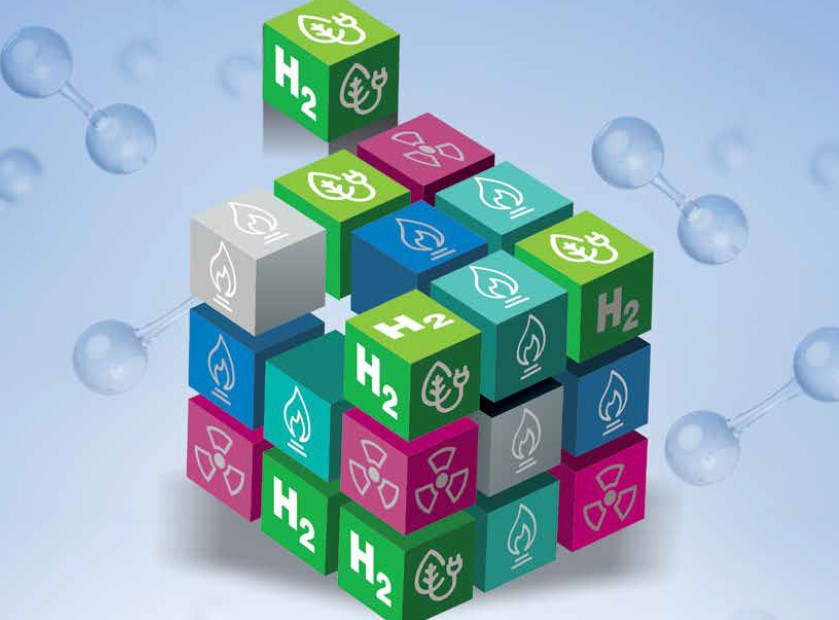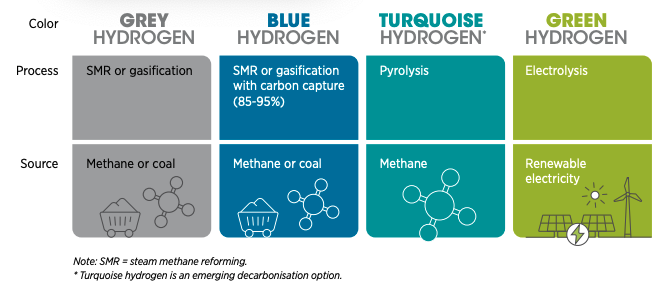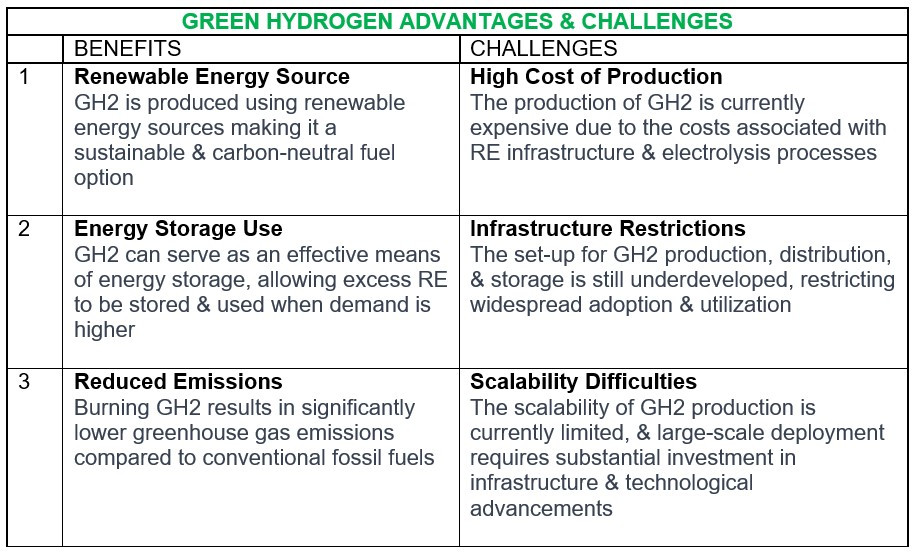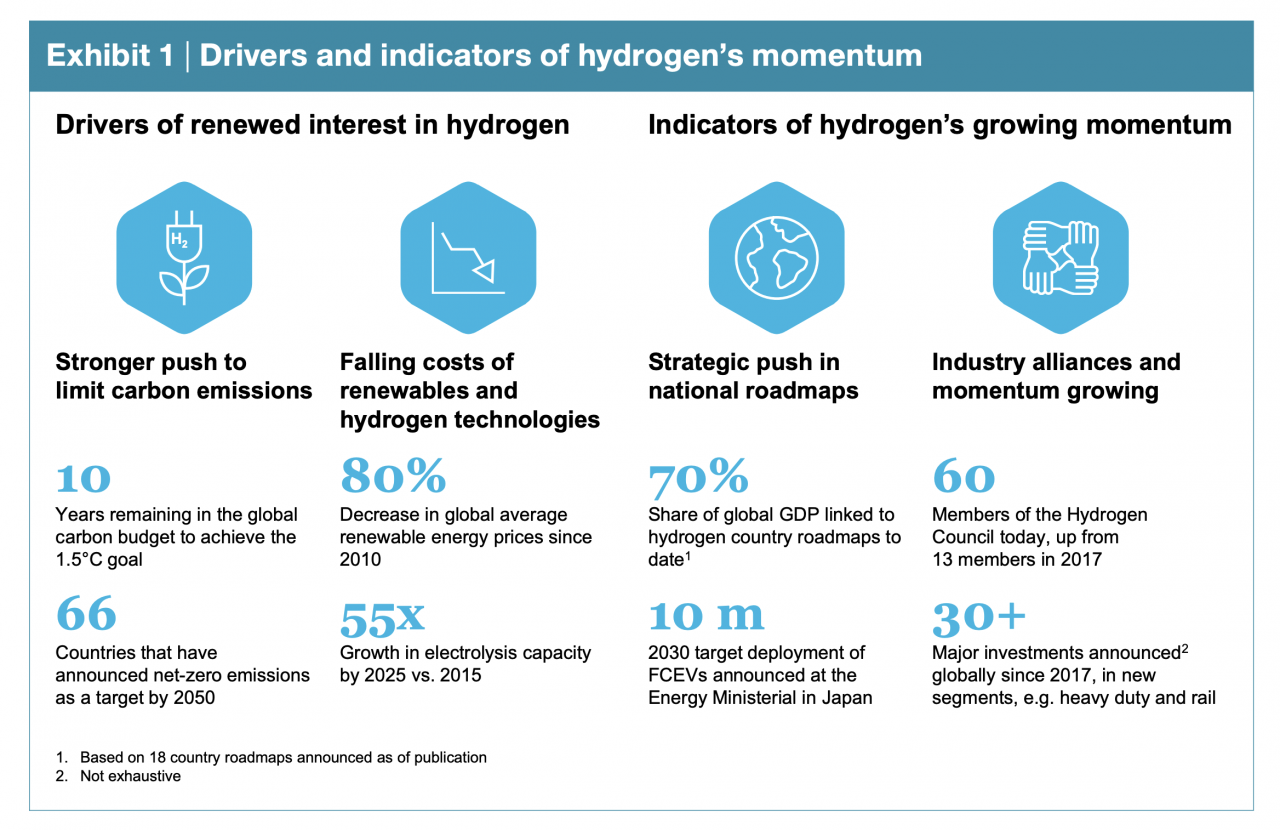Hydrogen energy: hope or hype? | Cover Story
A derivative fuel, a complementing energy source, a promising pathway to a net-zero future… there is a buzz around hydrogen lately. The amount of investment pouring into hydrogen tech, cannot be without reason, one would reason. At the same time, there are challenges that are making the potential element a seemingly far-fetched proposition. Let's take a look at the hope amidst all the hype.
Wonderfuel hydrogen
Since many years, hydrogen energy has increasingly become an important point of discussion with respect to the energy transition. Popular belief is that hydrogen as a green fuel is an ideal energy form, which when used gives out only water as a by-product and almost no emission. The fact is that not all uses of hydrogen give out water, and are not always emission-free. This perhaps is one of the conflicts that make it difficult to define the fine line between hype and hope. The point of contention, and one that is more evident, is the way in which hydrogen is produced.Deliberate choices are the only sacred things in the universe. Everything else is just hydrogen
James Alan Gardner
Color-coding production
Hydrogen can store and deliver usable energy, but it does not typically exist by itself in nature and must be produced from compounds that contain it. The process of hydrogen production can have environmental effects, and that needs to be addressed if it is to be produced on a large scale.
There are many ways of producing hydrogen, and for ease of understanding the method and its consequential impact on the environment, the resultant products have been color-coded. For example, hydrogen produced using renewable energy is called green hydrogen or GH2 (which is the most desired form); gray, black, and brown hydrogen refer to fossil-based production (which has high levels of CO2 emissions); and so on.
Most hydrogen is produced through steam methane (natural gas) reforming, a high-temperature process in which steam reacts with a hydrocarbon fuel to produce hydrogen. However, this technique releases greenhouse gases CO2 and CO into the atmosphere. Since, currently almost 95 percent of hydrogen production comes from fossil resources, specifically natural gas, it would mean that at present CO2 emissions from hydrogen production are quite high.
One way to overcome this problem is to apply a carbon capture and storage (CCS) system to the process, where substantial amounts of CO2 are captured and permanently stored underground or under water. Hydrogen produced using CCS is called blue hydrogen, which is referred to as a low-carbon energy carrier. However, the environmental impact of blue hydrogen depends upon effective CO2 removal and storage during its production.
The cleaner way to produce hydrogen is through electrolysis, using electricity. Here again, the source of electricity determines the impact on the environment. When the electricity used is generated from renewable sources, the hydrogen produced is GH2. But if electricity is from fossil-fuels, the hydrogen may be good to use but cannot be considered to achieve net-zero results.
While some GH2 production facilities have a dedicated RE supply, a substantial number of GH2 projects derive electricity from the grid, often where there is restricted RE supply. This could result in an additional burden on the existing grid. Concern is that RE demand for GH2 production may compete with RE that will be used for direct electrification processes across the economy.
Challenging proposition
Considering that most of the hydrogen in use today is fossil-based, the gradual and eventual shift to GH2 is going to create a huge demand for RE. Apart from a steady and inexpensive supply of renewable energy, there are several other challenges that need to be addressed in order to scale up its production and use. These include the high cost of production equipment, the need for appropriate infrastructure, storage and transportation of hydrogen, and the development of suitable technologies for different applications.In the endeavor to reduce emissions, it is imperative to first decarbonize hard-to-abate sectors like shipping, aviation, cement, steel, and in industries that already use gray hydrogen derived from natural gas, such as refineries, and fertilizers. This is where huge amounts of hydrogen will be required. Experts feel bule hydrogen could be an effective alternative.
According to Emre Gençer – Principle Research Scientist, MIT Energy Initiative, as stated in an MIT News article: 'It is very hard to meet this demand without leveraging existing production assets. The immediate and relatively cost-effective option is to retrofit existing plants with carbon capture and storage. State-of-the-art reforming with high CO2 capture rates, combined with natural gas supply featuring low methane emissions, substantially reduces GHG emissions compared with conventional natural gas reforming. Under these conditions, blue hydrogen is compatible with low-carbon economies.'
H-e-mobility drive
Another sector, where the use of GH2 is being greatly promoted is transportation. Hydrogen is being envisaged as a mainstream fuel for light vehicles like cars, with a few companies bringing out models that work on fuel-cell technology. The use is still under trial with very few commercial launches. The biggest hurdle in deploying fuel-cell cars is the lack of refuelling infrastructure. Besides, battery tech for e-mobility today is far more advanced, and related concerns regarding recharging, range and safety are already being addressed.

Hydrogen for sustainable aviation: Where are we now?
However, it is felt that hydrogen fuel cell propulsion could work well with heavy duty vehicles. Since heavy duty commercial vehicles work longer hours and can be fuelled in the same time as a regular vehicle, and can run longer because hydrogen fuel cells have a much higher rate of energy efficiency than ICE. This could be a cost-effective option for countries that are focussing on decarbonization of transportation, starting with long-haul, heavy vehicles.
Large-scale H2-driven e-mobility is a long-term play – not in years, but decades, feels Dr. Kamat: "Many technologies are at the demonstration stage and many others at the R&D stage, but the challenge is making them cost competitive with fossil-fuel-based vehicles and battery electric vehicles. H2-driven trucks seem to be a promising option to decarbonize trucking, while battery electric vehicles seem to be a better option for light-duty vehicles including two- and three-wheelers." Possibilities to run ships or airplanes on hydrogen-based fuels are at the R&D stage, and their potential would unfold as the R&D progresses, he says.
Settling with a hydrogen solution, if it were simple, would be an ideal solution. The biggest resistance to adopting H2 fuel-cells is that they require pure hydrogen as fuel, which would come at a cost, since using GH2 to power a road vehicle would require at least 2.5 times more renewable energy than a BEV.
In Europe, six environmental organizations have come together to dissuade the use of GH2 for transportation, stating: "If the use of green hydrogen or e-fuels for road transport were to be promoted, a large amount of additional RE would have to be generated to produce them, which would require the installation of a significant number of extra renewable energy plants, with the consequent impact on the territory and potentially on biodiversity."
The six European Organizations - Transport&Environment, SEO/BirdLife, Fundación Renovables, Ecologistas en Acción, ECODES, and Climate Strategy - demand that the government, within the framework of the current revision of the National Integrated Energy and Climate Plan (PNIEC), exclude e- fuels from road transport, and its use is concentrated in sectors such as aviation and most of maritime transport, where decarbonization cannot be easily achieved through direct electrification.
Best working solutions could probably be planned with existing fuels and systems. Like using blue hydrogen for industrial purposes, with focus on efficient carbon removal; like directly using ammonia in fuel cells, instead of breaking it down for hydrogen (transporting hydrogen is more expensive than moving ammonia); like altering existing production facilities, to save on costs for new infra; etc.
This probably could provide immediate-term solutions, especially when there is already a lot of work happening on RE generation to charge e-mobility. But with cost of renewables (especially solar) decreasing, maybe GH2 production might get the fillip it requires, to stand its ground. Despite the hubbub around hydrogen, it is a fact that all emerging tech go through a development curve, which takes time. And just like the growth of Li-ion, hydrogen tech too will come into its own.
Emerging tecH
In a recently held interview with ETN (Jan-Mar 2023 issue), Srikant Padmanabhan, President Engine Business – Cummins Inc, spoke about the latest technological megatrend emerging in the clean mobility space for heavy vehicles – the Hydrogen ICE. He said that Cummins is focusing on transforming an existing ignition ICE to be compatible with H2, or even other low-emission fuels like natural gas.
He said: "The reason why hydrogen ICE could be used in the transition path for the next 40 years is that it can replace diesels sooner than expected. The energy density in hydrogen ICE will be higher, much more efficient than battery-electrics in terms of range and refueling durations."
On the same lines, Yamaha, Honda, Suzuki, and Kawasaki recently announced a new research partnership that will consider the development of hydrogen-powered motorcycles that use ICE. The four manufacturers have received approval from Japan's Ministry of Economy, Trade, and Industry to form a research group called HySE (Hydrogen Small mobility & Engine technology), with each of the manufacturers assuming a different role in the ongoing studies.
JCB, an England-based manufacturer of earth-moving equipment, has revealed plans to introduce a hydrogen combustion engine for its next-gen diggers. It is estimated that there could be up to six billion kWh of demand for low-carbon hydrogen from transport by 2030. According to the UK government's hydrogen strategy, alternative fuel sources will be used across several transport sectors by 2030, including HGVs, buses, and rail.
In H2 production development, a team of scientists in the US - from the Department of Energy's (DOE) SLAC National Accelerator Laboratory, Stanford University, University of Oregon, and Manchester Metropolitan University - has discovered a method to extract hydrogen from the ocean by funneling seawater through a double-membrane system and electricity. This innovative design successfully generated hydrogen gas without producing large amounts of harmful by-products. The results of their study, recently published in the journal Joule, could help advance efforts to produce low-carbon fuels.
Developed under a US DoE solar cell technology project, a new method to achieve clean hydrogen directly from sunlight and water, offers a promising path to achieving net-zero carbon emissions. A University of Michigan research team, led by Prof. Zetian Mi, aims to stabilize perovskite-based solar cells to produce highly-efficient, low-cost, ultra-stable green hydrogen fuel.
Policy support
Hydrogen demand is projected to continue growing globally, encouraged in part by increasing support from government policies boosting decarbonization of fuel across many sectors of the economy. Talks of developing hydrogen economies have become a part of most global discussions, with substantial investments and supporting policies being planned to explore the potential of hydrogen as a clean energy carrier.
Several pilot projects have been launched to study the possible applications for hydrogen use, and to conduct viability studies for its transportation. Globally, governments are developing hydrogen strategies to position themselves as the first movers in this emerging market.
USA
According to the US DOE's Office of Clean Energy Demonstrations, the production, processing, delivery, storage, and end-use of clean hydrogen, including innovative uses in the industrial sector, are crucial to its strategy for achieving President Joe Biden's goal of a 100 percent clean electrical grid by 2035 and net-zero carbon emissions by 2050.
As a part of a larger $8 billion hydrogen hub program funded through the Bipartisan Infrastructure Law in the US, a Regional Clean Hydrogen Hubs program (H2Hubs) has been set that includes up to $7 billion to establish 6 to 10 regional clean hydrogen hubs across America. These hubs will create networks of hydrogen producers, consumers, and local connective infrastructure to accelerate the use of hydrogen as a clean energy carrier.
Hydrogen can play a critical role in the US net zero strategy, as a low-carbon fuel to support the decarbonization of hard-to-electrify energy demand sectors. The Inflation Reduction Act's 45V production tax credit is meant to incentivize the deployment of low-carbon hydrogen. The highest tax credits, for the lowest carbon hydrogen, reach up to $3/kg. However, the rules around the way the carbon intensity (CI) of hydrogen will be measured, and the potential allowance of mechanisms to offset emissions, such as Renewable Energy Credits (RECs), are still under development.
Europe
- Clean Hydrogen Partnership established in November 2021, to support research and innovation in the hydrogen ecosystem.
- Hydrogen and Decarbonised Gas Market Package, which puts forward proposals to support the creation of optimum and dedicated infrastructure for hydrogen, as well as an efficient hydrogen market.
- Important Projects of Common European Interest (IPCEIs) on hydrogen, to provide investment support.
United Kingdom
With the US and the EU speeding up the H2 bandwagon, UK too has been pushing environmental concerns, to find an alternative to fossil fuels. Analysis published in the UK Hydrogen Strategy indicated that low carbon hydrogen may increase from minimal use currently to comprising 20–35 percent of the UK's final energy consumption in 2050 - equivalent to 250–460 TWh, and similar in scale to present electricity use. In the Net Zero Research and Innovation Framework (2021), the government sets out key research and innovation (R&I) needs in hydrogen into the 2030s and beyond.
Global
The Clean Hydrogen Mission, under Mission Innovation, aims to reduce costs across the hydrogen value chain. The mission's focus areas are:- stimulating research, development, and innovation
- integration of production, storage, distribution, and end-use applications in hydrogen valleys, and delivery of 100 clean valleys worldwide by 2030
- preparing the ground for the scale-up of the hydrogen economy
As a part of the global initiative, India too has set out a National Green Hydrogen Mission, to promote the use of GH2 as a clean and renewable energy in the country, with an initial outlay of ₹19,744 crore (~$2.3 billion). Plans are to increase the country's annual GH2 production to 5 MMT by 2030. In February this year, ₹297 crore (~ $37 million) was allocated for hydrogen infrastructure, in the national budget 2023. This is to help facilitate the transition of the economy to low carbon intensity and reduce dependence on fossil fuel imports.
Going forward, Dr. Kamat points out, it is important to provide clarity in policy goals for GH2 and develop a green hydrogen strategy and a roadmap to implement that strategy. This would help in providing the necessary clarity to the markets and industry to make large long-term investments in GH2 infrastructure, he added, suggesting that broadly, GH2 cannot be the best option for all decarbonization goals, but it could work well as part of a toolbox along with many other decarbonization technologies.
Putting in perspective the role GH2 can have in energy transition, Dr. Kamat says: GH2 could potentially help one or more of three policy goals: (1) deep decarbonization (or decarbonization of hard-to-abate sectors) if green hydrogen use can replace fossil fuel uses or fossil-fuel-based hydrogen. (2) energy and materials security if domestic green hydrogen production can help reduce dependence on fossil fuel imports and imports of materials like ammonia and coking coal. (3) industrial growth if green hydrogen supports growth of existing industries such as renewable power production or if it supports emergence of new industries such as manufacturing of electrolyzers and other green hydrogen technologies. However, these goals might not always complement each other, and policy makers might have to prioritize among these goalsPromising premise
According to reports, as much as $500 billion could be spent globally on hydrogen development by 2030. Nations are already planning to scale up clean hydrogen production and consumption.
Analysis by the International Energy Agency (IEA) shows that investors in green hydrogen projects spent close to $700 million to complete hydrogen projects in 2022. An estimated investment of over $300 million has been made in projects under construction or starting operations this year, to supply H2 for industrial use.
An interesting media article on hydrogen buyers, which quoted Norway-based hydrogen research agency Rystad Energy, revealed that most of the GH2 offtakers in recent times are major industrial companies looking to decarbonize their existing use of gray hydrogen.
This rise in the buyers' interest in offtaking of yet-to-be-produced clean hydrogen, brings one's attention to the pricing of GH2. The market is yet to gather enough momentum to put in place a regulatory system, and lot depends on other influencing factors like cost of storage and transportation.
Keeping up the hype, the European Energy Exchange (EEX) recently launched 'Hydrix', - the first green hydrogen price index based on assessments provided by the market participants. It is an effort to improve price transparency, in a not-yet established trade in renewable hydrogen. According to EEX, the methodology of the index depends on industry contributors from both the production and consumption side, submitting a single buy or sell price (in €/MWh) each week, based on what they would theoretically be willing to spend or accept. Like explained earlier, there are many factors that will influence the price of clean hydrogen, once production is scaled-up and availability is easier and in an optimal form. Till then how useful the index will be in determining trade prices and investments, needs to be seen.
Despite the speculations and debates, it cannot be denied that hydrogen energy is a premise that holds a lot of promise. Yes, there are challenges, and many; figuring out viable solutions is not going to be easy. Hydrogen as a zero-emission fuel has a lot of possibilities, but it is also tricky to handle and deploy. Overcoming the challenges is crucial in sustaining the progress towards achieving clean energy goals.
The starker facts cannot be ignored; nevertheless, the exciting probabilities are what keeps the expectations into play. Deliberate choices with respect to hydrogen, will have to be made in the long run. Meanwhile, hype is good; it keeps hope afloat.


























